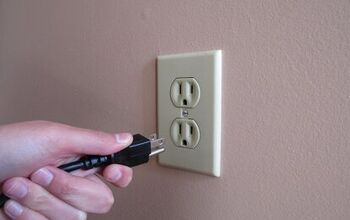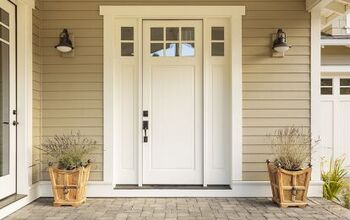How To Keep Your Pets Safe If You Live Near A Busy Road

Living near a busy road can be nerve-wracking if you have pets. The last thing anyone wants is to worry about their pets getting out and being hit by a car. That’s why you may understandably wonder how to keep your pets safe if you live near a busy road.
Supervise your pets when you take them outside and keep them on a leash if you live near a busy road. Establish boundaries in your yard and positively reinforce your dog to stay within them. Avoid using inhumane deterrents like sprays and shock collars that can harm your pets and cause anxiety.
Dogs and cats alike respond better to positive reinforcement than negative reinforcement. Follow along as we explore how to keep your pets safe if you live near a busy road.
How To Keep Your Pets Away From The Street
1. Supervise Your Pets
Supervision is of the utmost importance if you live near a busy road. Your pets may not understand how dangerous the road is. Because of that, they may freely wander onto the road without thinking twice about it.
It’s important to stay near your pets each time you let them outside to play or for any other reason. Get in the habit of encouraging them to come closer to you if they wander close to the road. Command words like “come” and “here” or simply using their name can draw them closer to you.
Supervision is necessary even if you have a durable fence. That’s because dogs and other pets can dig below a fence, crawl beneath it, and escape the yard. The only way to guarantee your pets are safe is to keep an eye on them when they’re outside.
2. Keep Your Cats Inside
Many homeowners have cats that they let go inside and outside freely. That is fine in some areas, but it’s a bad idea if you live near a busy road. Cats may be fast and have great reflexes, but they can’t account for reckless drivers.
Keep your cats indoors to reduce the risk of them going into the road and getting hit by a car. Even keeping them indoors most of the time doesn’t guarantee they won’t get into the road. For example, moving your cat from your house to the car for an appointment gives them a chance to run away.
You can reduce the risk of them getting outside if you put your cats in a carrier case for appointments. The same principle applies to small dogs and other pets that are hard to catch when they run free.
3. Install An Enclosed Catio
Catios, or cat patios, have taken the world by storm, and it’s for good reason. An outdoor enclosed catio provides cats with a safe place to play where they cannot escape. Keep in mind that “enclosed” is the keyword as some catios are open in certain spots.
Catios are fun play areas that are often fenced in. This lets a cat experience fresh air and gives them plenty of space for activities. Many cat owners find catios to be the perfect substitute for letting their cats roam freely outdoors.
You can find affordable catios that take little effort to install. Otherwise, you can build one out of fencing materials and wood. Fill your catio with cat trees, scratching posts, plenty of toys, and water for them to drink.
4. Keep Your Dog On A Leash
There’s no way to guarantee your dog won’t run into the street when you take them outside without a leash. It takes very little for some dogs to fixate on something, like a car, and run toward it. You can protect your dog and give yourself peace of mind if you keep your dog on a leash.
Give the leash plenty of slack so your dog can roam around as freely as possible without having total freedom. That way, your dog will feel independent and have space to exercise and play. Ideally, you should make sure your dog gets at least 30 minutes of activity per day, both inside and outside.
It’s also important to attach the leash to a harness. This provides extra support and security to keep your dog from getting loose. Fixed-length leashes are also helpful, as they don’t provide slack, which can be dangerous.
5. Be Careful When Playing Fetch
Unfortunately, many pet owners have learned the hard way that playing fetch is an easy way for their dogs to wind up in the street. All it takes is one hard throw for a ball to land in the street and for your dog to chase it. This can even happen if you throw the ball lightly and it rolls into the street.
Your best bet is to only play fetch in enclosed areas where there is no risk of the ball going into the street. Make sure to throw the ball onto a soft surface, like grass, so it doesn’t bounce and land in the street. Be careful not to throw the ball near a potentially dangerous obstacle, like rose bushes.
6. Be Careful With Pedestrians
Has a stranger ever approached your dog without asking you first? If so, then your dog may have freaked out and become aggressive. In other cases, dogs get excited and approach the stranger to get attention.
The problem with this is that you can’t guarantee how your dog will react. They may wind up in the street with a pedestrian or neighbor. Ideally, you should acknowledge the pedestrian first and handle the interaction before involving your dog.
It’s up to you whether or not you let them pet and interact with your dog. Nobody can blame you if you say “no” as you may be liable if your dog bites them. Furthermore, there’s a risk that your dog may follow the pedestrian into the street, and that’s dangerous.
7. Train Them
Training a dog takes a lot of time and patience, but it’s worth the effort. Don’t feel ashamed if you must enlist the help of an obedience trainer to train your dog to stay in the yard. They have the experience and skills to train dogs and pet owners alike.
An experienced dog trainer can teach you how to curb your dog’s behaviors without negative reinforcement. Otherwise, you can try it without help. First, establish a boundary in your yard that they cannot go past.
Walk them up to the boundary and once they reach it, say “no” and steer them in the other direction. Reward them as they obey you for the first few weeks, and then slowly stop rewarding them with treats. Practice the same method with commands like “stay” and “come” or “go” until your dog does what you want without prompts.
Are Invisible Fences Bad For Dogs?
Many people believe that invisible fences are bad for dogs. That’s because invisible fences are a form of negative reinforcement, which is widely considered to be bad. Negative reinforcement involves punishing pets for certain behaviors.
This can cause many problems for dogs, such as anxiety, depression, and fear. The last thing you want is for your dog to fear you or the repercussions of a simple mistake. Shock collars can hurt dogs and leave them shaken for hours or even days.
In extreme cases, they may even be fearful of your yard altogether because they don’t know where the shock boundary is. Shock collars are an unnecessary form of punishment for dogs. Many countries have banned shock collars, such as Wales, Sweden, Norway, Denmark, and Austria, among others.
Summing It Up
The best way to keep your pets safe if you live near a busy road is to keep them on leashes. Otherwise, you can train them to stay within the boundaries of your yard. Be careful when you play fetch and only throw balls on soft surfaces, so they don’t bounce and land in the street.
Related Guides:

Nick Durante is a professional writer with a primary focus on home improvement. When he is not writing about home improvement or taking on projects around the house, he likes to read and create art. He is always looking towards the newest trends in home improvement.
More by Nick Durante














![The 10 Best Table Saws - [2022 Reviews & Buyer's Guide]](https://cdn-fastly.upgradedhome.com/media/2023/07/31/9070645/the-10-best-table-saws-2022-reviews-buyer-s-guide.jpg?size=350x220)












